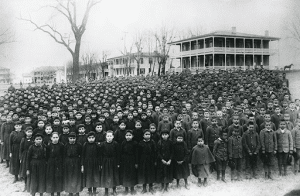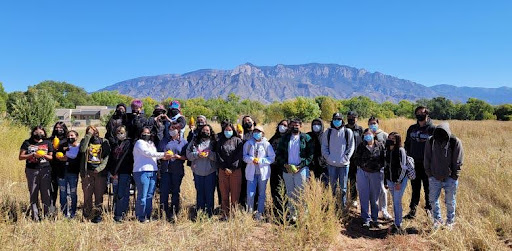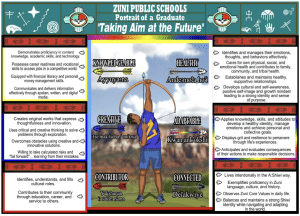Acknowledging the Indigenous Connections in CBE and Student-Centered Learning
CompetencyWorks Blog
By focusing on the whole child, real-world application, and learning in context, competency-based education (CBE) uses similar principles to traditional Indigenous education. Whether intentional or not in the initial design, we should acknowledge that CBE ideas reflect traditional Indigenous education approaches that long pre-date CBE. This blog post acknowledges the history of Indigenous education and how traditional Indigenous knowledge connects with competency-based education principles.
Traditional Indigenous Education
Before the arrival of European colonizers in the Plains, the Arikara resided in the region between the Missouri, Cannonball, and Cheyenne Rivers in what is currently known as North Dakota and South Dakota. For the Arikara – similar to many other Indigenous peoples – knowledge, skills, and culture were transferred by generations through storytelling and hands-on experiences.
Indigenous education transfers values, traditions, beliefs, customs, and accumulated knowledge and skills from one generation to the next. Traditional Indigenous education was community-based and typically correlated with day-to-day tasks associated with living in their environment. Learning in context through meaningful, relevant activities where learners build and apply their knowledge and skills directly resonates with CBE practices.
Federal Indian Boarding Schools
The first forms of Indigenous education created by European colonizers were common schools adapted by white missionaries in an attempt to assimilate Indigenous people into a eurocentric society. These schools specifically worked to dismantle Indigenous beliefs, languages, and cultural traditions that acted as barriers to Christianization. In 1819, starting with the Indian Civilization Act Fund, through the 1970s, the United States federal government implemented policies that continued this agenda of assimilation and cultural erasure. These policies established and supported Indian boarding schools and forcibly removed American Indian, Alaska Native, and Native Hawaiian children from their families and communities.
Choctaw Academy, located in what is now Kentucky, opened in 1825 as one of the first times the federal government was involved with Indigenous education, a role previously belonging to missionaries. Though it was a joint venture between the Choctaw Nation and the federal government, the curriculum promoted an Anglican view of the world and, later, a more American identity. The Academy acknowledged some Indigenous history but also promoted racist and inaccurate stereotypes that promoted the existing racial hierarchy. The primary purpose of Choctaw Academy, and other boarding schools, was assimilation. When Andrew Jackson was elected president in the 1830s, the idea of assimilation began to be replaced with full-on removal efforts of Indigenous peoples, and Choctaw Academy closed due to lack of funding in 1845.

After the Civil War and into the Progressive Movement, the US government increased educational requirements for Indigenous students, requiring them to be in boarding schools, in a further attempt at assimilation. By 1926, nearly 83% of Indigenous school-age children – including children as young as five years old – were attending boarding schools operated by the federal government and churches. Students suffered physical, sexual, cultural, and spiritual abuse and neglect while attending these schools, and many students never returned home. This abuse continued until the last boarding school closed in the 1990s.
Reckoning with the Truth and Addressing Ongoing Impacts
In June 2021, U.S. Secretary of the Interior Deb Haaland, the first Native American to hold a cabinet position, announced the Federal Indian Boarding School Initiative, “a comprehensive effort to recognize the troubled legacy of federal Indian boarding school policies with the goal of addressing their intergenerational impact and to shed light on the traumas of the past.” The first investigative report from the initiative catalogs historical records and develops the first official list of sites of federal Indian boarding schools. A next step in the effort, called “The Road to Healing,” followed from the recommendations to provide “survivors of the federal Indian boarding school system the opportunity to share their stories, help connect communities with trauma-informed support, and facilitate collection of a permanent oral history.”

Indigenous Education Today
In 2018, the National Congress of American Indians released a toolkit to “provide tribal nations the information and tools they need to assume more responsibility and oversight of the education of youth in their communities.” With around 90% of American Indian/Alaska Native students attending U.S. public schools and about 8 percent attending Bureau of Indian Education (BIE) schools, their educational experiences vary widely. Here we offer a few examples of schools with significant Native populations that create models using traditional Indigenous methods, which also resonate with the elements of competency-based education.

Enumclaw School District (ESD) in Washington state, which we recently featured in a post about culturally responsive teaching, developed a model for providing credit through Indigenous education courses. Students learn from elders and cultural experts while on canoe journeys in local environments. Students can use cultural experiences towards graduation requirements, aligning cultural learning to core learning standards.
Zuni High School in New Mexico separated from a larger district in 1980 to create an autonomous K-12 district for the Zuni reservation. The superintendent at the time, Hayes Lewis, said, “The community asked for a high-quality academic program with learning opportunities in and out of the buildings; power over making decisions and solving our problems; and an emphasis on Zuni culture, history, and language throughout the curriculum.” At the start of 2020, Zuni High School engaged in a community-driven portrait of a graduate process that reinforces the promise to the community to integrate Zuni language and culture into the education system.
Zuni High School is now shifting to competency-based learning and assessment. They realized that standardized testing was driving instruction, yet it didn’t work for their learners. They are shifting their mindset and practice to see the big picture for each student by creating a system that shows the progress a student has made, what they know, and what they can do.
The NACA Inspired Schools Network (NISN) is “building a movement of students, families, and educators to create excellent schools relevant to the communities they serve.” NACA is the Native American Community Academy, founded in 2006 in Albuquerque, New Mexico, which now serves students PK-12 with the mission to develop “strong leaders who are academically prepared, secure in their identity, and healthy.” The NACA model emphasizes community-driven design and culturally responsive education, including developing student agency, learning beyond the walls of school, and an annual demonstration of learning. NISN fellows, which are currently in five states, receive support to establish schools in Indigenous communities building from the NACA values and approach.
Shared Commitments for the Future
We aim to use the CompetencyWorks blog to help uplift and empower Indigenous voices. We hope it inspires dialogue and connection between educators, regardless of where they are in their journeys. The more stories we tell, the more examples of different approaches we can share, and the more people can find the examples and ideas to make their vision and dreams for their children a reality.
Competency-based education allows for multiple pathways to implementation. Our hope is that by learning about how others are approaching their work, we can explore our underlying shared values and acknowledge the origins of ideas that support our current thinking. In turn, this will allow us to better learn from each other and illustrate the beauty of multiple approaches.
We invite you to join us in this commitment to share your learning and ways you are acknowledging how the ideas of Indigenous peoples and others inform our work. Let us learn from those who came before us.
A Few Resources for Further Learning
- Indigenous Education (K-12) | Supports for Students | Programs | Calgary Board of Education
- ‘We’re still here’: past and present collide at a Native American boarding school
- “Weaving a Sense of Belonging” with Native American Community Academy (podcast)
- A Primer to Indigenous Education: A Case for Tribal Competency Crediting
- Education Choice for Indian Country: Supporting Tribal Decision Making for Schools and Students
- Federal Indian Boarding School Initiative | U.S. Department of the Interior
 Laurie Gagnon is the CompetencyWorks Program Director at the Aurora Institute. She leads the work of sharing promising practices shaping the future of K-12 personalized, competency-based education (CBE). Prior to her current role, she led learner-centered education design and systems change focused on performance-based assessment and CBE at reDesign and at the Center for Collaborative Education. Laurie began her professional life teaching English in Japan and high school history in the U.S. She lives in Somerville, MA with her partner, young son, and cat. She takes a learning stance in her work and life and believes that building relationships and understanding the perspectives of others offer powerful levers for creating new possibilities.
Laurie Gagnon is the CompetencyWorks Program Director at the Aurora Institute. She leads the work of sharing promising practices shaping the future of K-12 personalized, competency-based education (CBE). Prior to her current role, she led learner-centered education design and systems change focused on performance-based assessment and CBE at reDesign and at the Center for Collaborative Education. Laurie began her professional life teaching English in Japan and high school history in the U.S. She lives in Somerville, MA with her partner, young son, and cat. She takes a learning stance in her work and life and believes that building relationships and understanding the perspectives of others offer powerful levers for creating new possibilities.

Briana Medina joined the Aurora Institute as an intern with CompetencyWorks in May 2023. She is currently a junior at the University of Wisconsin-Madison studying Political Science and Education Studies. She is committed to educational equity and passionate about its relation to competency-based learning. She currently serves on the UW-Madison College of Letters and Science Curriculum Committee, where she reviews and recommends course and program additions, revisions, and policies relating to academic offerings. In the past, Briana has worked as an intern at Kettle Moraine School for Arts and Performance, giving tours and teaching in a competency-based learning environment. Additionally, she worked with the Institute for Personalized Learning leading panel discussions, making presentations, and writing blog posts.